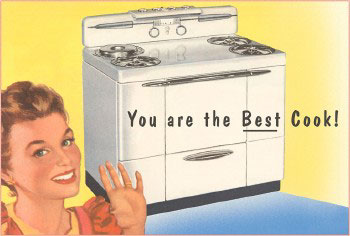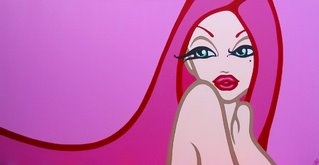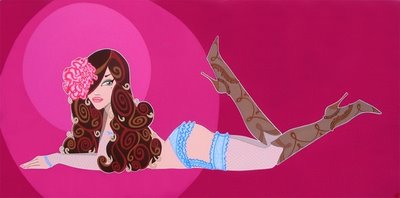My InDePeNdEnT StUdY...x
Priya Negi
"If you think prison is hell for a man, imagine what it's like for a woman". Discuss how women are represented in the television drama Bad Girls.
‘Bad Girls’ is a British television drama serial, which has been on air since 1999. “It is set in the fictional women’s prison of Larkhall, and features a mixture of serious and light storylines focusing on the prisoners and staff of G-wing.”
This drama shifts away from the usual British television drama serial, and instead explores the issues that can be seen to hidden away from society, thus making it a one of a kind serial. Each episode comes to terms with the struggles that women in ‘G-Wing’ face and their constant efforts to deal with mistakes they previously made which lead them to where they are now. The main target audience can be said to be 17-25 year olds. However regardless of this target audience many others can also watch ‘Bad Girls’. The programme can also attract a male audience, however both audiences female and male interpret the text differently. This essay focuses on how women are represented in the “multi- award winning drama” although it can be said that the representation of women in the media today has progressed, one can use different theorists and texts to justify this progression. ‘Bad Girls’ is a text that can be interpreted to challenge the usual stereotypes of women conforming to society’s rules and regulations; it breaks free from the homemaker “a homemaker is a person whose prime occupation is to care for their family and home” or the successful woman. Instead ‘Bad Girls’ emphasises and analyses women in society that have not abided by the rules, women from all backgrounds and shown to be contained in Larkhall Prison.
A mixture of personalities and view women that have been “banged up” for various crimes some including: murder, arson, robbery and even petty theft on numerous occasions. ‘Bad Girls’ itself is produced by Shed Productions, Shed have produced over two hundred hours of prime time television. Since the 1970’s when feminism rose there has been many changes to how women are represented. Although women can be seen to be subordinate to men, texts such as ‘Charlies Angels-Full Throttle’ (Director: McG, 2003) and ‘Kill Bill volumes 1 and 2’ (Quentin Tarantino, 2003/2004) are examples of contemporary texts that challenge these typical stereotypes.
1 http://en.wikipedia.org/wiki/Bad_Girls_(TV_series)
2 http://www.badgirls.co.uk/library/lib_bg5/bg5_index.html
3 http://en.wikipedia.org/wiki/Homemaker
4 http://www.badgirls.co.uk/library/lib_bg5
Gunter (1995) said that from the 1950’s to the 1970’s only ’only 20 to 30 per cent ’of characters were female yet by the mid 80’s there were more female characters with leading roles’ However the women that were shown on television were seen to be in marriage, parenting and often showed much interest to domestic activities. This can be seen to be the post-war time, where all women were seen to be good for was looking after children and the home, being labelled a ’home-maker’. It was these very representations, that set an example to how women were seen as in society and women who were to break away from these set rules could be seen to be purely mad. As feminism grew upon people, changes were made. The first wave of feminism was during the nineteenth century and early 20th century which was in the UK and the US. It focused on what was known as ’de-jure’ inequalities, ’ and primarily gaining the right of women’s suffrage’ The second wave of feminism focused upon ‘gaining equality throughout society and eliminating oppression for women’ this was during the early 1960’s and lasted through the late 1980’s. Some of the major events that took place in the second wave of feminism were ‘The commission on the status of women was created in the USA by the Kennedy administration with Eleanor Roosevelt as its chair. ‘
The report issued by that commission in 1963 documented discrimination against women in virtually every area of American life.’Following on that same year the book ‘The Feminine Mystique’ (Betty Freiden, 1963) appeared on bookshelves. Finally the third wave of feminism was aimed to challenge the stereotypes of women and the sexualities of these very women. Third wave feminists often focused on ‘micro politics’ often writing about forms of gender oppression and representation. Feminism was the movement for women, that amongst everything made texts appear to be made different and thus challenged certain thoughts about how women were seen on and off screen. When comparing ‘Bad Girls’ with how representations of women used to be like, one can see that a lot has changed over the years. Many of the plots in ‘Bad Girls’ revolve around the women themselves doing things they should not have done. For example one can take Amanda Barrie who features in ‘Bad Girls‘. Barrie had a number of television roles in the 1960’s and 1970’s, the roles in which she played were just the average ‘Madonna‘ roles. She appeared in the Carry On films and then appeared in the ITV1’s ‘Bad Girls’ and reinvigorated herself as one of the ‘Costa Cons’A totally new character which literally said ‘goodbye to the Madonna and hello to the Whore!’ This is just one example of how a specific actress had changed roles following her career in the 1960’s compared to now.
5 Gauntlet, David Media, gender and identity
7 Manuel Alvarado, John Stewart (1985) Made For Television (Page 3)
8 http://www.aber.ac.uk/media/Documents/gaze/gaze09.html
9 Susan Sage Heinemann (1994) Representing Women
10 http://en.wikipedia.org/wiki/Third-wave_feminism
Thinking about Laura Mulveys theory ‘The male gaze’ which was purely stating that women were there for men’s eyes only "to-be-looked-at-ness." “Mulvey suggests that there were two distinct modes of the male gaze of this era: "voyeuristic" (i.e. seeing women as 'Madonna’s') and "fetishistic" (i.e. seeing women as 'whores')” An example of some of these typical women can be seen in texts such as ’Grease’ (1979, Randal Kleiser) Olivia Newton John was seen in one scene to want to be noticed by John Travolta, therefore she was seen to undergo a makeover where she wore a sexy black tight cat suit and had lots of make up on. This can refer back to Laura Mulvey’s theory of ’The male gaze’. In ‘Bad Girls’ one can see the characters of a few women as being the ‘whore’. Natalie Buxton, played by Danielle Brent and Janine Nebeski, played by Nicole Stapleton can be seen as two of the character sin ‘Bad Girls’ that can be seen to follow many of the conventions of a ‘whore’. The way in which they dress, and their actions also play an extremely big part in how they can be perceived. It can be said that the previously made films and programmes made television what it has become today.
Films that have given women the chance to shine, and be the protagonist have made it possible for an all women based drama serial to be televised. The infamous Sigourney Weaver was the protagonist of the film ‘Alien’ (Ridley Scott, 1979) ‘Alien became both a critical and box-office success, spawning a successful Hollywood franchise of literature, video games, merchandise, and three official sequels.’ This film can be seen to set the standard for many other texts, it was a positive representation for women then made them leap forward.
‘Bad Girls’ not only represents the ‘whore’ but it also pays tribute to the ‘Madonna’ . Being confined in prison one may think that all of the prisoners of Larkhall have a boring, life. However looks can deceive, these women of G-Wing are no ordinary women, they still can mange to smuggle in alcohol and drugs leading to even more problems in the prison. Women of all types are represented in ‘Bad Girls’, different ethnic minorities are also shown, and different age groups. This variety of ages and ethnic minorities aims to appeal to the many different audiences that may decide to watch the programme. Although feminism has helped bring society to where it is now, there have been some struggles that it has had to face. Gaye Tuchman (1978) said that females were represented far less then men on television. This can be argued to be true as the 1970’s were only starting to try and break away from the usual home-maker/family minded woman. In comparison to what now has being a playground to the many programmes that we can choose to view ‘Sex and the City, Sugarush, Ally McBeal’ etc. All of these programmes listed are programmes that aim to break free from the typical representation of women and move towards the ‘new-age woman’.
11 http://en.wikipedia.org/wiki/Bad_Girls_(TV_series)
12 http://movies.yahoo.com/movie/preview/18088996
13 Nicholas Bill (1985) ‘Movies and Methods’ (page 203)
14 http://en.wikipedia.org/wiki/Alien_(film)
Another programme that consisted of the same storyline was ‘Prisoner: Cell Block H’ it was originally a Australian television soap opera. It was set in Wentworth Detention Centre, a fictional women’s prison. It was so successful in the UK, it became on the “most enduring in Australian television history” This show was controversial in many aspects, some of the main issues raised were homosexuality, social reform and feminism. When the series launched in 1979, the press advertising used the line "if you think prison is hell for a man, imagine what it's like for a woman". Initially causing some stir about how a man and a women would deal with being in prison, the series was a first in its kinds to show off these aspects and thus seemed a huge success with the British public. When comparing the two texts ‘Bad Girls’ and ‘Prisoner: Cell Block H’ one can see that they share some of the same codes and conventions. Both analyse the detail to which the women of ‘Block H’ and ‘G-Wing’ deal with “incarceration, and separation from their families. Within the walls of the prison, the major themes of the series were the interpersonal relationships between the prisoners, the power struggles, friendships and rivalries”
Sadly many had to see ‘Prisoner: Cell Block H’ to and end. However after the cliff-hanger of 1981 a television special was screened and went by the name of ‘Prisoner in Concert’. The concert itself consisted of the cast performing sketches and songs. A programme that was released around the time of this was ‘Punishment’ made by the same organisation that made ‘Prisoner: Cell Block H’ Reg Grundy Organisation. However instead of focusing on women, it focused on men; surprisingly the show was not a success “Network Ten deemed the new series a failure” after only 3 episodes being aired it was quickly removed.
15 http://en.wikipedia.org/wiki/Prisoner_Cell_Block_H
16 http://en.wikipedia.org/wiki/Prisoner_Cell_Block_H
17 http://en.wikipedia.org/w/index.php?title=Prisoner_Cell_Block_H &redirect=no
18 http://en.wikipedia.org/wiki/Punishment_%28TV_series%29
When analysing how men can interpret the text ‘Bad Girls’ one has to take into account many aspects of the programme. Some aspects may include media language, genre, how exactly the women are represented and maybe even the narrative itself. Due to some of narratives in ‘Bad Girls’ such as Janine Nebeski and her promiscuous nature, Natalie Buxton and her sexy, manipulative manner, some of the male audience may view visual pleasures whilst watching the programme. This could thus refer back to Laura Mulvey’s theory of how the ‘male gaze’ resulted in the male audience to drool over the erotic exhibition of women’s bodies on the screen The year 1991 brought a new programme to screen which went by the name of ‘Dangerous Women’ Dangerous Women premiered August 7, 1991 and aired only one season. It too followed the same codes and convention of ‘Prisoner: Cell Block H’ ‘Prisoner’ and ‘Bad Girls’ however on of its main taglines was “Behind every good man there's a dangerous woman."
We can see an on-going theme, most if not all of the programmes mentioned all refer to the way in which men can be treated in prison, and the ways in which women are treated is prison. Various taglines and successes help to show this. ’Bad Girls’ has been built up of various drama serials over the years which helped it to break out into the UK television market. Perhaps one could argue that because there have only been a unique minute amount of programmes made about ‘women in prison’ this maybe the cause to their success. However on the other hand one could argue that, making a programme that has not yet been ‘tried and tested’ for the intended audience can be tricky and prove to be a risk. Either way drama serials have come and gone and ‘Prisoner: Cell Block H’ was a rock in time, that outstand all of the rest of the drama serials as it was the first of its kind to bring up issues such as homosexuality and feminism.
19 Bennett, Peter (2006) ‘A2 Media Studies: the essential introduction
20 http://en.wikipedia.org/wiki/Dangerous_Women
21 http://www.badgirls.co.uk/library/lib_atoz/atoz_index.html
Another main issue raised by the televisions serial ‘Bad Girls’ has to do with sexuality and promiscuousness. The women in Larkhall prison are “as good as they come” from lesbians, to prostitutes the prison has them all. Representing a variety of roles, the programme has come to grips with the most shocking stories of its time. ‘Julie Saunders’ played by Vicky Alcock, is serving her time in prison, yet comes across something she certainly would not think she would…cancer. The way in which the programme aired these episodes was absolutely striking. Breakthrough Breast Cancer received over 600 calls in response to the two episodes of Bad Girls after which ITV promoted their information line details. A third of those callers asked for further information. This is regarded as
an unprecedented achievement for a TV drama.
More so other serials that can be seen to be portraying women in totally different ways then ‘Bad Girls’ can be seen to be for example in ‘Clueless’ although the two genres are noticeably different it just goes to show how differently women can be portrayed. Clueless’s tagline being “Sex, Clothes and Popularity. Is there a problem here?” One can also see that the ratings for Clueless are extremely high, perhaps one could argue that Laura Mulveys theory on ‘The male gaze’ is true and that all male audiences want to see is the sexy, seductive women. Mulvey distinguishes between two modes of looking for the film spectator: voyeuristic and fetishistic, which she presents in Freudian terms as responses to male ‘castration anxiety’. Programmes such as ‘Bad Girls’ just show how the oppression of women has calmed down and made it to where it is now. Although it is fair to say there still are women being discriminated all over the world today, however the extent to which they were 20 odd years ago has changed. The main change coming across from representation and all aspects of it, how women have been represented over the years has caused this change. Perhaps if we still were seeing home-makers and family orientated women, ’Sex in the City’ would not have been made. If society was like how it was at the beginning of the first wave of feminism then we would not have seen female protagonists, perhaps not even the programme ‘Bad Girls’ due to its touching of subjects that seem to have a stigma attached to them.
22 http://en.wikipedia.org/wiki/Clueless
23 http://www.aber.ac.uk/media/Documents/gaze/gaze09.html
24 Richard Dyer (2002) The Matter Of Images: Essays on Representations (page 1)
The oppression and discrimination of women has largely been discussed and various campaigning has lead to women being able to vote, and also laws and regulations which do not allow any discrimination against women at work etc. Dating back from 1651-1695, a Mexican nun that was a very well known activist that went by the name of Sor Juana she was not only a scholar but a proponent of women’s education. In conclusion all of the images and representations we have seen in the media “the analysis of the kind that has burgeoned in the past twenty years, starting with work on women and black people, spreading to other marginalized and oppressed groups such as, ethnic minorities, lesbians and gay men, the disable and the aged” the list is endless. Nevertheless instead of dwelling on how many people are oppressed in society one has to consider how the oppressed groups have changed or are changing. Thus when considering women and the oppression they have/do suffer one can say that the representation of women has not only given them the chance to be the successful role model, but also move away from the typical household duties. From the Glades ‘Shake and Vac’ advert to the infamous women of the ‘Loreal’ hair products adverts ‘Because I’m worth it!’
Website and Book References
[1] http://en.wikipedia.org/wiki/Bad_Girls_(TV_series)
[2] http://www.badgirls.co.uk/library/lib_bg5/bg5_index.html
[3] http://en.wikipedia.org/wiki/Homemaker
[4] http://www.badgirls.co.uk/library/lib_bg5
[5] Gauntlet, David Media, gender and identity
[6] Bennett, Jacquie (2005) ‘Media Studies: AS & A2’ pg. 22
[7] Manuel Alvarado, John Stewart (1985) Made For Television (Page 3)
[8] http://www.aber.ac.uk/media/Documents/gaze/gaze09.html
[9] Susan Sage Heinemann (1994) Representing Women
[10] http://en.wikipedia.org/wiki/Third-wave_feminism
[11] http://en.wikipedia.org/wiki/Bad_Girls_(TV_series)
[12] http://movies.yahoo.com/movie/preview/18088996
[13] Nicholos Bill (1985) ‘Movies and Methods’ (page 203)
[14] http://en.wikipedia.org/wiki/Alien_%28film%29
[15] http://en.wikipedia.org/wiki/Prisoner_Cell_Block_H
[16] http://en.wikipedia.org/wiki/Prisoner_Cell_Block_H
[17] http://en.wikipedia.org/w/index.php?title=Prisoner_Cell_Block_H
&redirect=no
[18] http://en.wikipedia.org/wiki/Punishment_%28TV_series%29
[19] Bennett, Peter (2006) ‘A2 Media Studies: the essential introduction
[20] http://en.wikipedia.org/wiki/Dangerous_Women
[21] http://www.badgirls.co.uk/library/lib_atoz/atoz_index.html
[22] http://en.wikipedia.org/wiki/Clueless
[23] http://www.aber.ac.uk/media/Documents/gaze/gaze09.html
[24] Richard Dyer (2002) The Matter Of Images: Essays on Representations (page 1)








